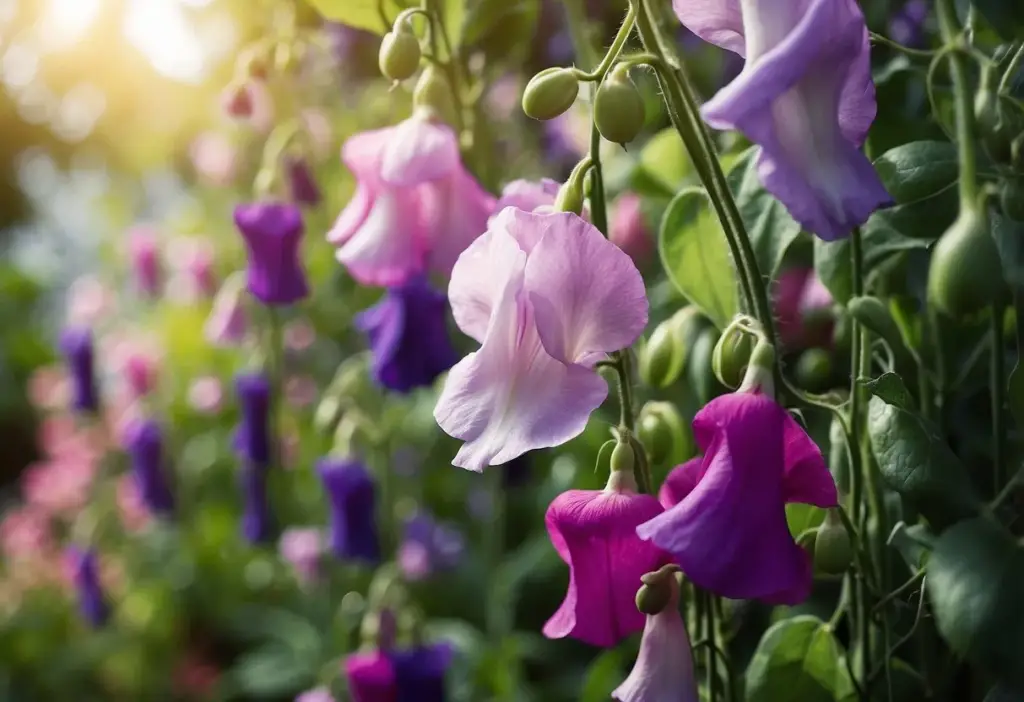
You may add a wonderful scent and a splash of color to your landscape by growing sweet peas. Because of their lovely blossoms and delightful perfume, gardeners have adored these attractive flowers for ages. When they grow as bushy plants or climb elegantly on trellises, they may be a beautiful addition to any garden. Are you unsure of the best ways to utilize sweet peas in your garden? There are many inventive ways to care for your sweet peas so they flourish and improve your outside area. With a little forethought and attention, you can enjoy a healthy sweet pea garden—from selecting the ideal spot to offering the necessary support.
Vertical Trellis Setup
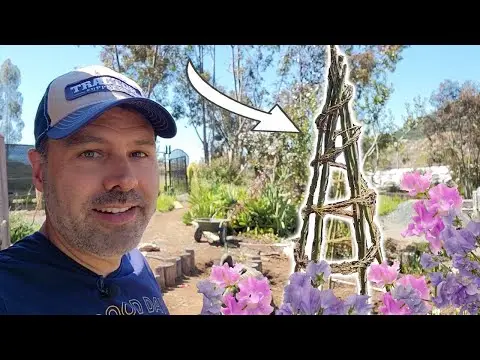
A vertical trellis is an excellent solution for growing sweet peas. It saves space while encouraging upward growth, which keeps your plants healthy and well-structured.
To make one, use bamboo stakes paired with garden twine. Simply insert the stakes into the ground, then crisscross the twine to form a grid-like framework for the sweet peas to climb.
If you want something more dramatic, try using a garden arch or tunnel. These sturdy structures work wonders for vining plants, offering a stunning vertical element that adds visual interest to your garden.
For an easy DIY approach, repurpose your wooden fence. Hammer nails in a grid, then use twine to create climbing supports for the peas. You can also opt for a metal trellis for a more durable, visually appealing addition to your garden.
Custom Painted Garden Stakes

Add some flair to your garden with custom-painted stakes. Not only do they support your sweet peas, but they also bring a splash of color and creativity.
Personalize your stakes by painting them in vibrant hues or matching them to your garden’s overall theme. This can turn your plant supports into unique decorative features, adding a fun and whimsical touch.
Get creative and involve family members in the painting process. It’s an enjoyable activity that transforms ordinary stakes into memorable pieces.
Rustic Wooden Planters
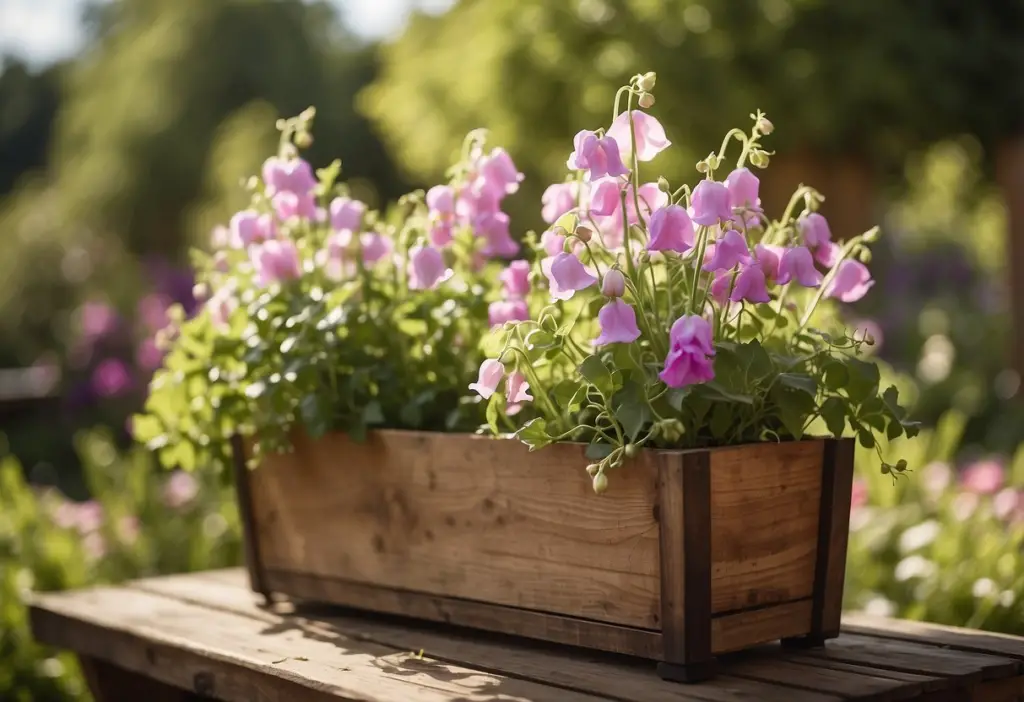
Building rustic wooden planters for your sweet peas is a fantastic way to blend charm and functionality. Start by sourcing logs or reclaimed wood, such as Lodge Pole Pine, to create a natural, weathered look.
A basic rectangular shape works well, providing ample space for plant roots to spread. Stack the logs, securing them to create a strong frame, and you’ve got a durable, rustic planter that complements the rest of your garden.
This hands-on project not only gives your sweet peas the support they need but also adds an earthy, organic aesthetic to your outdoor space.
Sweet Pea Archway
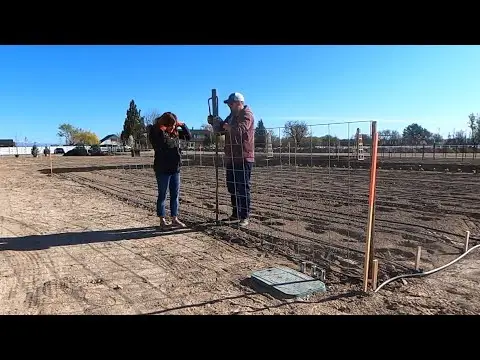
A sweet pea archway can become a focal point in your garden. First, choose a sunny spot and gather sturdy supports, such as flexible willow rods.
Plant sweet pea seeds in rows about two inches apart along both sides of the arch base. Water them thoroughly and protect them from pests as they begin to grow. Use twine to gently guide the vines as they climb.
By weaving the vines through the structure regularly, you’ll create a lush, floral arch that not only looks stunning but also fills the air with delightful fragrance.
Fairy Garden Accents
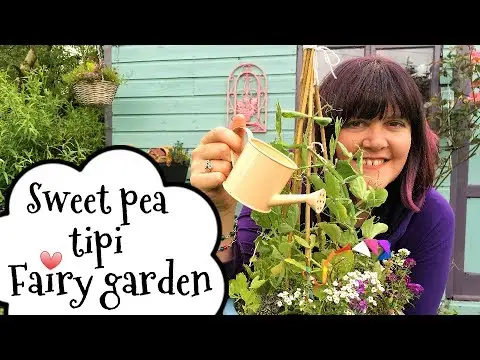
Transform your sweet pea garden into an enchanting scene with fairy garden accents. Small fairy houses, benches, and tables tucked between the plants can evoke a whimsical, magical atmosphere.
Miniature lanterns, birdbaths, and pebble paths add to the fantasy, creating a delightful escape within your garden. These tiny details can make your garden feel like an otherworldly haven.
DIY Sweet Pea Teepees

Building DIY sweet pea teepees is a fun and functional way to grow your plants. Start with bamboo stakes and garden twine to form a simple, circular structure.
Place the stakes into the ground in a teepee shape, tying them together at the top. Then, wrap twine around the stakes to create a framework for the plants to climb.
This easy project not only gives your sweet peas the support they need but also makes for a playful family activity.
Hanging Basket Display
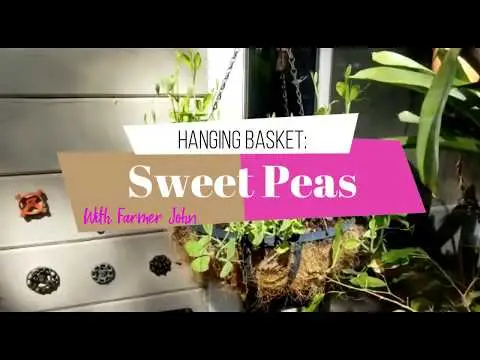
Hanging baskets offer a great way to showcase sweet peas in small spaces. Soak the seeds overnight, then plant them in seedling trays. Once they’ve grown to about six inches tall, transfer them to the basket.
Choose a basket with good drainage and plant 4-6 seeds per 12-inch pot. Hanging baskets bring a cascade of vibrant color and fragrance to your outdoor space without taking up much room.
Vintage Garden Tools
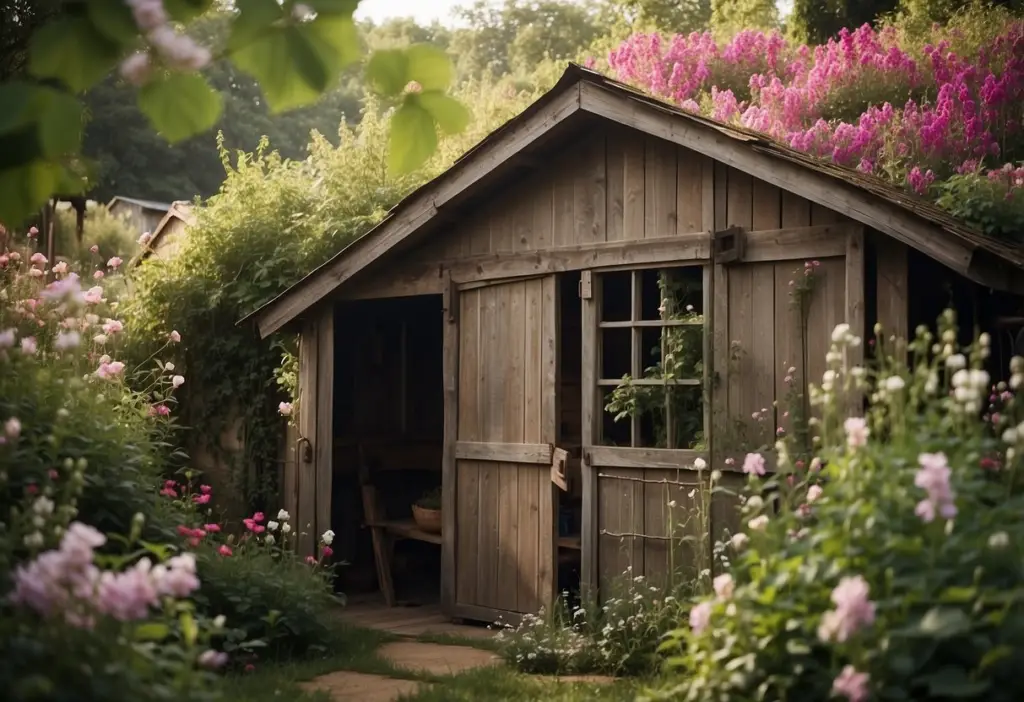
Incorporating vintage garden tools adds a nostalgic touch to your sweet pea garden. Old rakes, shovels, and watering cans make charming décor pieces that enhance the garden’s rustic vibe.
You can hang an old rake on a wall as a quirky display, or even repurpose it as a jewelry holder. Vintage tools can also be turned into wind chimes, adding a musical note to your garden’s charm.
Incorporating Sweet Peas in Bouquets

Sweet peas are perfect for bouquets, adding both beauty and fragrance. Their bright colors and soft petals create a striking contrast when paired with green fillers like eucalyptus or ferns.
When arranging a bouquet, combine sweet peas in different shades to create a dynamic look. Keep the flowers in a clean vase, and they’ll brighten up any room while staying fresh longer.
Perfumed Sweet Pea Varieties
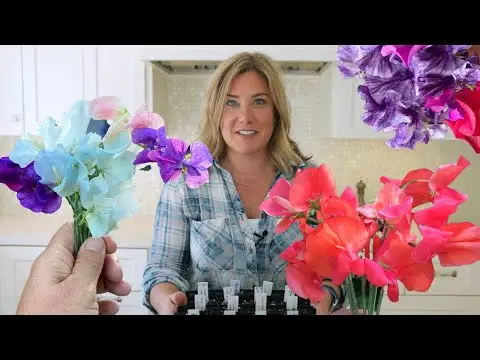
For those who enjoy fragrant blooms, certain sweet pea varieties are sure to enhance your garden. Try planting Lathyrus odoratus ‘Matucana’, known for its striking maroon and purple flowers.
Lathyrus odoratus ‘Noel Sutton’ is another option, with large, frilly purple blooms that emit a delightful scent. For a richer color palette, consider Lathyrus odoratus ‘Beaujolais’, with deep red blooms that stand out in any setting.
Choosing the Right Varieties

Picking the right sweet pea varieties ensures your garden is both beautiful and aromatic. Consider whether you want heirloom or hybrid varieties, depending on your preferences for fragrance and appearance.
Heirloom sweet peas are known for their intense fragrance and vibrant hues, making them a favorite among traditional gardeners.
Hybrid varieties offer specific advantages, such as disease resistance and extended bloom times, though they may lack the strong scent of heirloom types.
Choosing fragrant varieties like ‘Beaujolais’ or ‘Matucana’ will give your garden a sensory boost with their rich colors and captivating scents.
Planting Techniques

To plant sweet peas successfully, ensure that your soil is well-prepared and your support structures are sturdy. Proper spacing is also key to promoting healthy growth and abundant blooms.
Soil Preparation and Fertilization
Sweet peas thrive in nutrient-rich, well-drained soil. Enhance your soil by adding compost or aged manure before planting. A bit of bone meal will help promote strong root development, and potassium-rich fertilizers can encourage more vibrant flowers.
Make sure the soil has a pH between 6.0 and 7.0 for optimal growth.
Spacing and Support Structures
Plant sweet pea seeds about one inch deep and three inches apart. Once the seedlings are established, thin them out to five inches apart to give each plant room to grow.
For climbing varieties, install trellises or other supports that are at least eight feet high to help the vines climb easily. Bushier varieties may only need simple stakes to keep them upright.
Care and Maintenance

Taking care of your sweet peas involves consistent watering, mulching, and keeping an eye out for pests. These practices ensure healthy growth and a long blooming season.
Watering and Mulching
Sweet peas need about an inch of water per week. Make sure to water the soil, not the leaves, to avoid fungal diseases. Applying a 2-3 inch layer of mulch helps retain moisture and prevent weeds from growing.
Keep an eye on the soil’s drainage to avoid root rot.
Pest and Disease Control
Sweet peas can be affected by pests like aphids and spider mites. Regularly inspect your plants and, if needed, use insecticidal soap or neem oil to tackle infestations.
Diseases such as powdery mildew can also strike, so maintaining good air circulation is key. Slugs and snails can damage your plants, but setting up barriers or traps can help deter them.

